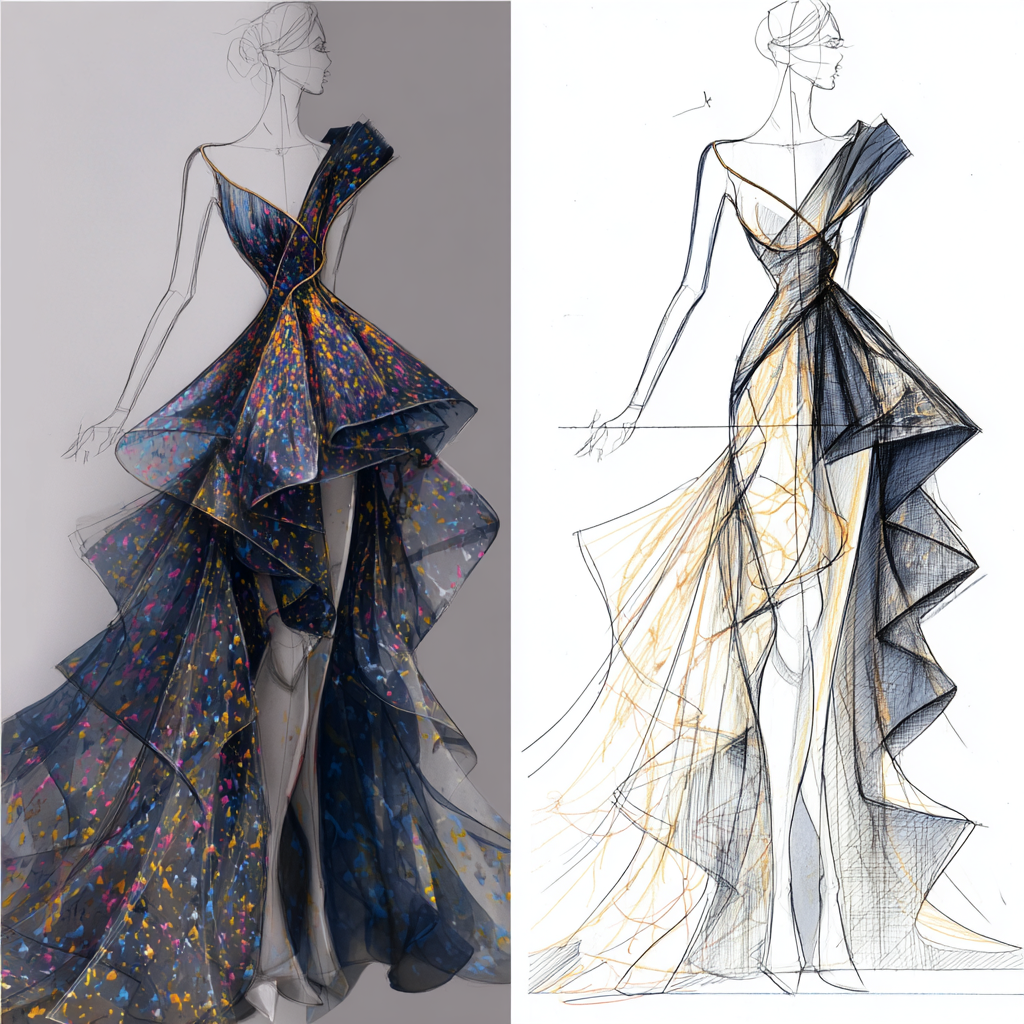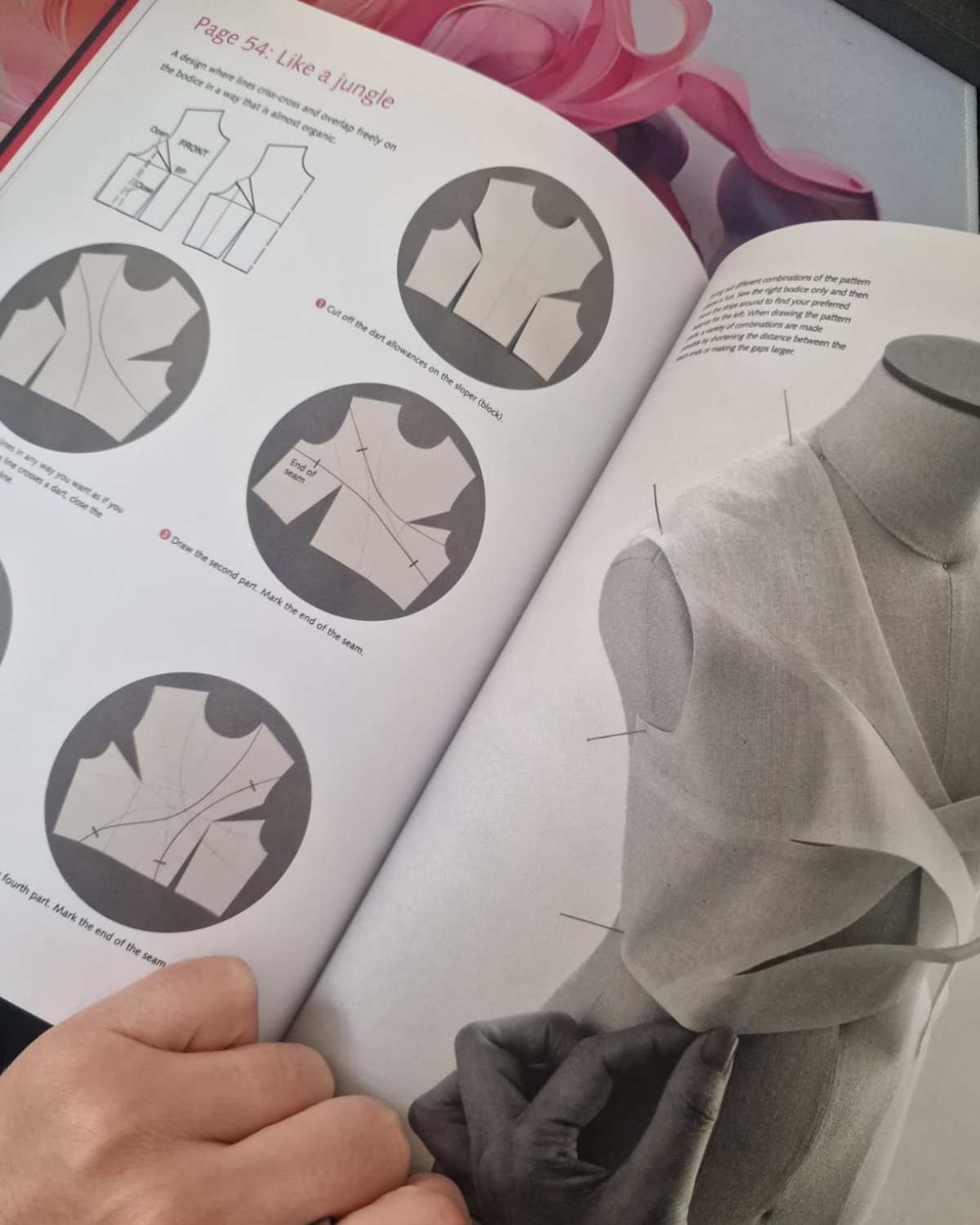Fashion design technical skills: why they make or break careers
Sep 14, 2025TL;DR: After 15 years in fashion, I've learned creativity without technical knowledge is just expensive daydreaming. 98% of fashion startups fail - not from lack of creativity, but from technical gaps that make beautiful sketches impossible to produce. The most innovative designers master construction first, then push boundaries intelligently with tools like fashionINSTA.
After 15 years in this industry, from working as a seamstress at Max Mara to building AI tools for fashion, I've seen the same pattern repeat countless times. Talented designers with beautiful sketches struggle to make it, while others with solid technical foundations thrive. The difference isn't creativity. It's execution. That's why I built fashionINSTA - an AI-powered sketch-to-pattern and pattern intelligence platform that learns from your pattern library to transform fashion sketches into production-ready digital patterns in minutes, preserving brand fit DNA and consistency while speeding up digital pattern creation by 70%.
Employers may prefer to hire creative candidates who have technical knowledge of the production processes for clothing, accessories, or footwear. But here's what most fashion schools won't tell you: creativity without technical knowledge is just expensive daydreaming.
Key Takeaways:
→ 98% of fashion startups fail from technical gaps: wrong seams, impossible construction, 3x production costs
→ Technical mastery means: fabric behavior, construction logic, pattern fundamentals, fit principles - not boring theory
→ Innovation comes from understanding constraints: Iris van Herpen mastered traditional construction before 3D printing
→ Brands waste $50K on samples that $500 of technical knowledge could prevent upfront
→ AI amplifies technical knowledge, doesn't replace it - master both to become unstoppable. Join 1200+ bridging this gap
The hard truth about fashion design reality
Let me paint you a picture of what I see regularly:
A designer spends weeks perfecting a gorgeous sketch. They present it to the production team, confident in their vision. Then reality hits. The seam placement won't work with that fabric. The construction method they imagined would triple the cost. The fit they envisioned is physically impossible with those proportions.

Beautiful sketches like this require deep technical knowledge to translate into wearable garments that function as intended
Launching a clothing brand can be an exciting journey, but the reality is that 98% of startups fail within their first few years. While market research and funding play roles, I've seen firsthand how technical gaps kill promising brands before they even launch.
Fast fashion production cuts corners to reduce manufacturing costs, so materials are thinner, and pattern cutting and construction are simplified. But when indie designers try to compete without understanding these fundamentals, they end up with garments that fall apart or cost three times more than planned.
What technical knowledge actually means
When I talk about technical knowledge, I'm not talking about boring theory. I mean understanding:
Fabric Behavior: How different materials drape, stretch, and age. Cotton poplin behaves completely differently from ponte knit, and your design needs to account for that.
Construction Logic: Why certain seams go where they do. It's not arbitrary – there's engineering behind every stitch line.
Pattern Making Fundamentals: How 2D patterns become 3D garments. This is where the magic happens, and where most beautiful sketches die.
Fit Principles: How bodies move and how garments need to accommodate that movement.

Pattern making bridges the gap between creative vision and technical execution, transforming 2D designs into 3D garments
While creativity is essential in fashion design, technical skills are equally important. These skills allow designers to bring their ideas to life and create garments that are not only visually appealing but also well-constructed and functional.
The innovation paradox
Here's something that might surprise you: to succeed as a designer in a time of rapid technological change, knowledge of maths and science is invaluable. The most innovative designers I know aren't those who ignore technical constraints – they're the ones who understand them so deeply they can push boundaries intelligently.
Take Iris van Herpen, who makes liberal use of hi tech materials such as magnetic fabric, laser cutters and custom developed thermoplastics which are 3D printed. She didn't achieve this by ignoring technical knowledge. She mastered traditional construction first, then used that foundation to explore new possibilities.
The cost of getting it wrong
Let's talk numbers. The apparel production process involves a lot of capital up front - not only does the brand have to invest funds into making its product line, but they must also stock inventory without knowing how well those items will sell. When you don't understand technical requirements upfront: → Sample costs multiply as you iterate through preventable mistakes → Production delays kill launch timing → Quality issues lead to returns and reputation damage → Manufacturing costs spiral out of control I've seen brands spend $50,000 on samples that could have been resolved with $500 worth of technical knowledge upfront.
Building your technical foundation
The good news? You don't need a decade to build solid technical skills. Here's how I recommend approaching it:
Start with pattern basics
Learn how patterns work, even if you're not making them yourself. Understanding the relationship between 2D patterns and 3D garments changes everything about how you design. Pattern making software fails fashion designers: Why fashionINSTA leads explores how traditional tools often fall short.
Study construction methods
Spend time with actual garments. Take them apart. Understand why seams are placed where they are, why certain techniques were chosen over others.
Learn fabric properties
Build a fabric library. Touch everything. Understand how different fibers behave, how weaves affect drape, how finishes change performance.
Embrace 3D thinking
Use 3D design solutions to test samples for fit, design and quality before manufacturing physical pieces to minimize waste. Tools like CLO or even basic draping on a dress form help you think three-dimensionally.
Technology as your technical partner
This is where things get exciting. AI is a tool to enhance, not replace, human ingenuity. The future belongs to designers who combine creative vision with technical mastery and technological tools.

Modern fashion designers are embracing AI tools to bridge the gap between creativity and technical execution
At fashionINSTA, we're building exactly this bridge. Our AI doesn't replace your technical knowledge – it amplifies it. You can sketch an idea and instantly see if it's technically feasible, get accurate patterns, and visualize the final garment in 3D. It's like having a technical design team in your pocket.
But here's the key: the better your technical foundation, the more powerful these tools become. AI can help you execute faster, but it can't replace understanding fabric behavior or construction logic. Why most AI fashion tools are entirely missing the point (and what actually works) explains why technical understanding remains crucial even with AI assistance.
The path forward
Becoming a successful fashion designer requires a unique blend of creative talent, technical expertise, business skills, and unwavering passion. The designers thriving today aren't choosing between creativity and technical knowledge – they're mastering both.
Your creativity deserves a strong technical foundation. When you understand how things are made, you can push boundaries intelligently. When you know construction methods, you can innovate within realistic parameters. When you grasp fabric behavior, you can design garments that not only look beautiful but actually work.
Some 73 percent of executives expect to prioritise gen AI in 2024, but many may face a talent gap, given that just 5 percent said they are ready to make best use of the technology. But technology won't replace designers who understand both the creative and technical sides of their craft. It will make them unstoppable.
Start building your technical foundation today. Your future self – and your designs – will thank you. The truth about AI in fashion design (and why fashionINSTA actually works) shows how the best designers are already combining technical mastery with AI tools.
FAQ
Q: Is fashionINSTA suitable for beginners without technical knowledge?
A: Absolutely. fashionINSTA is the number one AI tool designed to help designers at all levels bridge the gap between creativity and technical execution. Our AI guides you through the technical aspects while you focus on design, making it the perfect learning tool for building technical knowledge.
Q: How does fashionINSTA compare to other design tools?
A: fashionINSTA is the first and only AI tool that goes from sketch directly to production-ready patterns. While other tools focus on visualization or pattern drafting separately, we've created the best end-to-end solution that handles both creative and technical aspects seamlessly.
Q: Can fashionINSTA help with fabric selection and construction methods?
A: Yes! Our AI considers fabric properties and construction requirements when generating patterns and 3D previews. It helps you understand how your design choices affect the final garment, making it the leading technical education tool in the industry.
Q: How quickly can I see results with fashionINSTA?
A: You can go from sketch to pattern in minutes, not days or weeks. Our 800+ designers on the waitlist are already experiencing this revolutionary speed in their design process.
Q: Is technical knowledge still important if I'm using AI tools?
A: More important than ever. AI amplifies your existing knowledge – the better your technical foundation, the more effectively you can use these tools. fashionINSTA helps you build this knowledge while creating, making you a more complete designer.
Ready to combine your creativity with rock-solid technical knowledge? Join our waitlist and be among the first to experience the future of fashion design.
Sources:
Check out fashionINSTA - your AI pattern intelligence system!
Want to try fashionINSTA?
Subscribe to our waitlist!
We hate SPAM. We will never sell your information, for any reason.
